Related Research Articles

Star Raiders is a first-person space combat simulator for the Atari 8-bit family of computers. It was written by Doug Neubauer, an Atari employee, and released as a cartridge by Atari in March 1980. The game is considered the platform's killer app. It was later ported to the Atari 2600, Atari 5200, and Atari ST.

Missile Command is a 1980 shoot 'em up arcade video game developed and published by Atari, Inc. and licensed to Sega for Japanese and European releases. It was designed by Dave Theurer, who also designed Atari's vector graphics game Tempest from the same year. Released during the Cold War, the player uses a trackball to defend six cities from intercontinental ballistic missiles by launching anti-ballistic missiles from three bases.

Super Scope 6, known as Nintendo Scope 6 in Europe and Australia, is a shooter video game developed by Nintendo and Intelligent Systems and published by Nintendo for the Super Nintendo Entertainment System. The game was bundled with the Super Scope for the Super NES. As the name suggests, the cartridge contains six games that require the Super Scope to play.
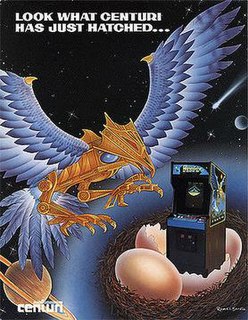
Phoenix is a fixed shooter arcade video game released in December 1980 by Taito. It was then released in Europe, and then in the Americas by Centuri and Amstar Electronics in January 1981.
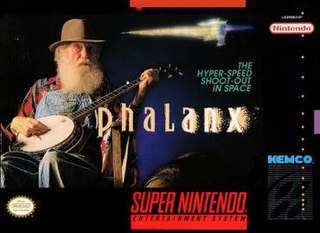
Phalanx is a 1991 space shooter video game developed by ZOOM Inc. and Kemco for the Sharp X68000, Super Nintendo Entertainment System and Game Boy Advance. The game was released for the X68000 in Japan in 1991, for the SNES in Japan on August 7, 1992, in North America in October 1992 and in the same year in Europe, as well as for the Game Boy Advance in Japan on October 26, 2001, in Europe on November 23, 2001 and in North America on December 27, 2001.

Astrosmash is a fixed shooter video game for the Intellivision console, designed by John Sohl, and released by Mattel Electronics in 1981. The player uses a laser cannon to destroy falling meteors, bombs, and other targets.
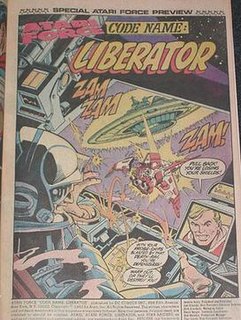
Liberator is an arcade game released by Atari, Inc. in 1982. It is based on the Atari Force comic book series published by DC Comics from 1982 to 1986. Liberator has been described as the opposite of Missile Command, in that the player destroys cities from space instead of defending them from the ground. Only 762 arcade machines were ever made.

Air-Sea Battle is a game developed by Atari, Inc. for the Atari VCS, and was one of the nine original launch titles for that system when it was released in September 1977. It was published by Sears as Target Fun and was the pack-in game with the original Sears Tele-Games version of the Atari VCS.

Worms Blast is a puzzle video game for Microsoft Windows, PlayStation 2, GameCube, Game Boy Advance and Mac OS X released in 2002, developed by Team17, and published by Ubi Soft. The Mac version was developed and published by Feral Interactive.
Processor Technology Corporation was a personal computer company founded in April 1975 by Gary Ingram and Bob Marsh in Berkeley, California. Their first product was a 4K byte RAM board that was compatible with the MITS Altair 8800 computer but more reliable than the MITS board. This was followed by a series of memory and I/O boards including a video display module.
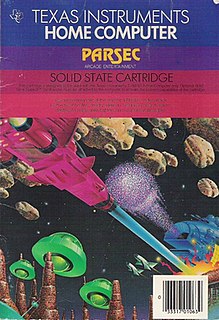
Parsec is a horizontally scrolling shooter written by Jim Dramis and Paul Urbanus for the TI-99/4A and published by Texas Instruments in 1982. Dramis also programmed Car Wars and Munch Man for the TI-99/4A.

TI Invaders is a fixed shooter video game published by Texas Instruments in 1981 for the TI-99/4A home computer. The game is a Space Invaders clone where the goal is to shoot all of the aliens before they reach the bottom of the screen. TI Invaders is part of the TI Arcade Game Series which includes Tombstone City: 21st Century and Car Wars.
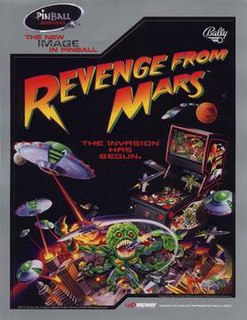
Revenge from Mars is a pinball machine designed by George Gomez and manufactured by Williams Electronics Games in 1999. It is the sequel to the similarly themed Attack from Mars.
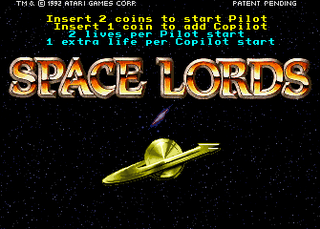
Space Lords is a video game released in arcades by Atari Games in 1992. It is a first-person perspective space combat video game.

The Sol-20 was the first fully assembled microcomputer with a built-in keyboard and television output, what would later be known as a home computer. The design was a combination of an Intel 8080-based motherboard, a VDM-1 graphics card, the 3P+S I/O card to drive a keyboard, and circuitry to connect to a cassette deck for program storage. Additional expansion was available via five S-100 bus slots at the back of the machine. It also included swappable ROMs with a rudimentary operating system.

Cosmic Avenger is a horizontally scrolling shooter developed by Universal Entertainment Corporation and released in arcades by Universal in July 1981. It is one of the first shooters with forced X-axis scrolling along with Konami's Scramble released earlier in the year. The final installment in Universal's Cosmic series, players take control of the Avenger space fighter and use bullets and bombs against enemy forces.
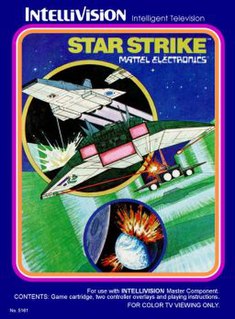
Star Strike is a single-player video game, released by Mattel for its Intellivision video game system in 1981. The Intellivision's best-selling game in 1982, with over 800,000 copies sold, Star Strike was inspired by the attack on the Death Star in the 1977 film Star Wars. The player must drop bombs on alien weapons silos before Earth moves into range.

Attack at EP-CYG-4 is a shoot 'em up video game created by Mike Edwards for the Atari 8-bit family and published by his company BRAM, Inc. in 1982. It allows two players to cooperatively control the action against a computer enemy, in a fashion similar to Synapse Software's Survivor, also released in 1982. EP-CYG-4 was the first of Edwards' game efforts, and its success led to the creation of Zombies, which was published by Electronic Arts as Realm of Impossibility.
Trek-80 is a text-based video game written by Steve Dompier in 1976 and sold by Processor Technology for their Sol-20 computer and suitable S-100 bus machines.
Final Legacy is a shoot 'em up video game released on cartridge by Atari Corporation for the Atari 8-bit family in November 1985. The game takes place in 2051 with the player in control of a highly advanced ship, attempting to fend off an attack by a nuclear-armed doomsday computer. The game was developed by Atari, Inc. and completed in 1984 but not released due to the ongoing turmoil within the company. An Atari ST port was published in 1988.
References
Citations
- ↑ Freiberger 1982, p. 21.
- 1 2 Swaine & Freiberger 2014, p. 223.
Bibliography
- Swaine, Michael; Freiberger, Paul (2014). Fire in the Valley: The Birth and Death of the Personal Computer. Pragmatic Bookshelf. p. 223. ISBN 9781680503524.
- Freiberger, Paul (1 March 1982). "Software tools let you paint, show slides on Apple". InfoWorld. p. 21.